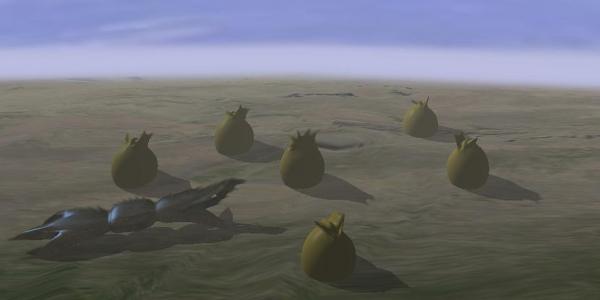BY LETTER
Puffer Patch
Sessile underground predator on Ridgewell | |
 Image from Steve Bowers | |
| An unsuspecting stonebear wanders into a puffer patch's killing ground | |
General Information
Native to the northern forests of Ridgewell, the Puffer Patch is a small predator that spends most of its life in a sessile state, but is capable of using metamorphosis to change to a mobile form when environmental conditions require it.In its sessile form a puffer patch most closely resembles a large patch of Terran 'puffball' mushrooms. An area of the forest floor some 1 to 3 meters across is covered in small brown spheres each about 1 centimeter across with each sphere separated by about three times its own diameter. Each sphere is actually the swollen tip of a thin tendril, which extends downward into the ground to where the main body of the Puffer Patch has buried itself, usually about a third of a meter below the surface. A puffer patch's body is a leathery, wrinkled ovoid shading from dark brown to black and about the size of two baseline fists held together.
When small animals (usually nocturnal foraging species) pass through the patch and brush up against the spheres they cause them to rupture, releasing neurotoxic spores that rapidly paralyze the animal while still inside the patch. Fine digestive tendrils are then extruded from the surrounding puffballs and proceed to attach themselves to the animal and consume it. The dissolved substance of the victim is transported by the tendrils down to the actual main body of the Puffer Patch below the ground. Most prey is completely consumed within a few planetary days and the puffer patch (which has spent the time regrowing the spheres ruptured during its 'attack') is ready for its next meal to wander into its 'spheres of influence'.
Mating and Reproduction
Puffer patches are hermaphroditic with each animal being both male and female. Mating takes place in the spring with each patch growing specialized 'mating spheres' along the edges of their feeding patch. When an animal brushes these spheres, they rupture and coat the animal with reproductive spores that also act to prevent the feeding spheres of their home patch from activating. The animal then wanders off and eventually encounters another patch, which kills and consumes it, impregnating itself in the process. Gestation takes a planetary year, at which point the patch grows several 'birth spheres' which eventually rupture to release several dozen beetlelike 'seedlings' which scatter across the forest floor where they will consume dead plant and animal matter while growing rapidly for several months before eventually burying themselves in the ground. Once buried each seedling spins a cocoon and metamorphosis into a small puffer patch, which extrudes tendrils ending in puffer spheres up to the surface.Mature Metamorphosis
While the puffer patch spends most of its adult life in an unmoving form waiting for prey to come along, it is not completely immobile. On occasion drought, disease, or other conditions will result in a localized drop in prey animals. When this occurs an individual patch may enter a sort of hibernative state, withdrawing most of its spheres and lowering its already slow metabolism to wait for more favorable conditions. However, on occasion it may reactivate the cocoon spinning habits of its youth and once again enclose itself in a transformative shell. After several weeks of metamorphic change the patch emerges from its cocoon in a form rather like a Terran mole, but still covered in dark wrinkled skin instead of fur. The motile form has a strong sense of smell and hearing, but very poor vision. It digs itself to the surface (usually at night) and heads off in search of more favorable real estate. Often a motile may travel for several days, burying itself during daylight hours and reemerging at dusk to continue its travels. When a new suitable locale is found, the patch buries itself one final time and re-cocoons itself for the transformation back to its sessile form.Interactions with Terragens
When Terragens first came to Ridgewell, the puffer patch was a minor annoyance, its toxic spores causing skin and nasal irritation but little else in most bionts. Nanomedical and immune systems handled it easily. Later a genetic tweak, standard in most native inhabitants in the present era, made Terragenic lifeforms immune to puffer patch toxins.Related Articles
Appears in Topics
Development Notes
Text by Todd Drashner
Initially published on 02 August 2005.
Initially published on 02 August 2005.






